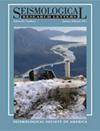ShakeMap Atlas 4.0 和 AtlasCat:近期和历史地震震动图档案,以及对全球灾害分析和损失模型校准的影响
IF 3.2
3区 地球科学
Q2 GEOCHEMISTRY & GEOPHYSICS
引用次数: 0
摘要
地震档案研究通常侧重于事件和震源特征,以用于地震目录、地震构造理解和地动研究--其中许多研究的目标是为概率地震灾害分析提供更好的约束条件。相比之下,ShakeMap 地图集侧重于历史事件的震动空间分布,为每个事件中经历过显著震动的所有地点提供最佳约束条件,促进对人类经历、损害和诱发危险(地面破坏)的分析。地震动图集》的目的是全面了解和描述一系列典型地震的震动分布情况,并结合每个事件的损失数据,为地震损失模型校准等提供依据。虽然开发 ShakeMap 图集的最初动机是校准美国地质调查局 (USGS) 的全球地震及时评估响应系统,但随着时间的推移,该图集已被证明是用户的有用工具,因此,在最新版本中,其范围已大大扩展。第四版美国地质调查局 ShakeMap 图集是一个公开的资料汇编,包含 1900 年至 2020 年间全球 14,000 多次重大地震的 ShakeMaps。此次修订包括(1) 最新版本的 ShakeMap 软件,提供了完善的不确定性估计和改进的方法,以将宏观地震观测与更新的地动模型相结合;(2) 更新的震源目录;(3) 基于新的地震构造区域化方案选择预测和转换方程套件的完善策略;(4) 扩展的宏观地震烈度和地动数据集。我们还以表格形式列出了 Atlas 事件的经济损失和死亡报告,只要这些数据是公开可用的。这些变化使新的 ShakeMap Atlas 成为一个自洽的、经过校准的目录,对于研究近源地动以及地震灾害、情景、风险和损失模型的开发和测试都非常有价值。本文章由计算机程序翻译,如有差异,请以英文原文为准。
ShakeMap Atlas 4.0 and AtlasCat: An Archive of the Recent and the Historical Earthquake ShakeMaps, and Impacts for Global Hazard Analyses and Loss Model Calibration
Archival earthquake studies often focus on event and source characteristics for use in earthquake catalogs, seismotectonic understanding, and ground-motion studies—many of these targeting better constraints for probabilistic seismic-hazard analyses. The ShakeMap Atlas, in contrast, focuses on spatial distribution of shaking for the historical events, providing the best constraints at all locations that experienced significant shaking for each event, facilitating analyses of human experience, damage, and induced hazards (ground failure). The aim of the Atlas is to gain a general understanding and depiction of the shaking distribution for a suite of canonical earthquakes, and, coupled with loss data for each event, to provide a basis for earthquake loss model calibration, among other uses. Although the initial motivation for developing the ShakeMap Atlas was calibrating the U.S. Geological Survey (USGS) Prompt Assessment of Global Earthquakes for Response system, over time, the Atlas has proved to be a useful tool for its users, and, as such, its scope has been vastly expanded in this newest version. The fourth version of the USGS ShakeMap Atlas is an openly available compilation of over 14,000 ShakeMaps of significant global earthquakes between 1900 and 2020. This revision includes: (1) the latest version of the ShakeMap software that provides refined uncertainty estimations and improved methods to combine macroseismic observations with updated ground-motion models; (2) an updated earthquake source catalog; (3) a refined strategy to select suites of prediction and conversion equations based on a new seismotectonic regionalization scheme; and (4) expanded macroseismic intensity and ground-motion datasets. We also tabulate reported economic losses and fatalities for Atlas events where such data are openly available. These changes make the new ShakeMap Atlas a self-consistent, calibrated catalog invaluable for investigating near-source ground motions, as well as seismic hazard, scenario, risk, and loss-model development and testing.
求助全文
通过发布文献求助,成功后即可免费获取论文全文。
去求助
来源期刊

Seismological Research Letters
地学-地球化学与地球物理
CiteScore
6.60
自引率
12.10%
发文量
239
审稿时长
3 months
期刊介绍:
Information not localized
 求助内容:
求助内容: 应助结果提醒方式:
应助结果提醒方式:


